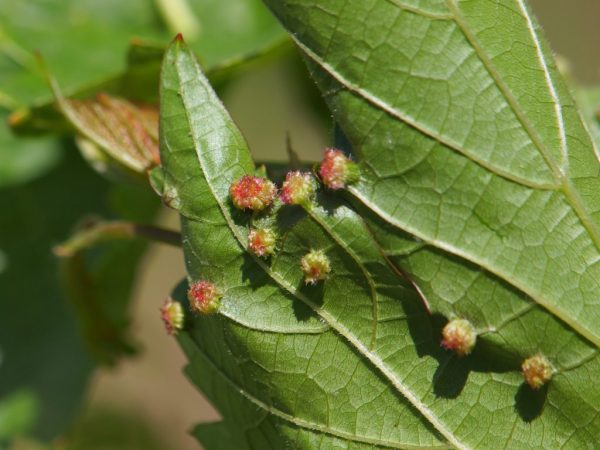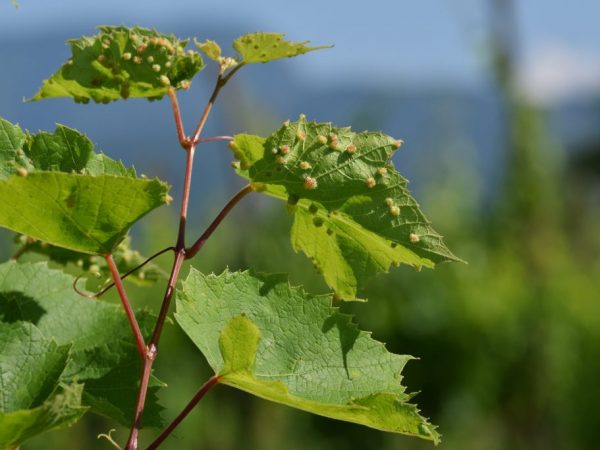Fighting phylloxera on grapes
Phyloxera on grapes, better known as the grape aphid, is common. Subtle, small in size, it feeds on the vegetative parts of the plant, harming the vine and reducing yields.

Fighting phylloxera on grapes
Biological characteristics of phylloxera
Phyloxera of grapes is a disease caused by insects. In length, it reaches no more than 1 mm. The shape of the body is oval, color - from yellow to light green. It has a sucking proboscis, through which it feeds on plant sap, creating an obstacle to the full flow of nutrients into plant cells. The period until the complete destruction of the vine due to damage to the vegetative parts by the pest is from 3 to 5 years. The insect reproduces along the entire perimeter. During the season, it gives from 8 to 14 generations.
The source of the spread of the disease is North America. It was introduced to Europe in the 19th century. Then an epidemic of the spread of the pest was noted, and its appearance caused damage to the viticulture of Europe.
Varieties
There are 2 main types of the disease:
- leafy phylloxera;
- root.
Sheet
The habitat of the leafy variety is grape foliage. Her color is dirty yellow. Grape phylloxera leaf forms galls, in which it lives, feeds, and grows offspring.
The leafy variety on grapes mainly affects the mother plants of rootstock vines.
Root
The grape root variety is distinguished by the absence of wings and dark spots on the yellow-green back. She prefers to settle in the roots, sucking out the plant sap, leading to the death of the culture and thereby weakening the plant. In winter, it does not die, retains its vital activity in the root system or in the soil layers, deepening to a distance of 3 m from the surface.
With the onset of spring heat, when the air temperature warms up to 10 ° C and higher, the larvae emerging from the laid eggs begin to feed and actively lay eggs in the grape wood.
Signs of appearance
The larvae of the pest move to healthy plants through the purchased infected grafting and planting material, along with technical equipment and on the grower's shoes. They travel long distances with air masses and rain streams.
Signs of the presence of a pest on the vine are indicated by:
- dense, deformed, warty, spherical formations in the form of swelling of areas affected by grape aphids on the lower and upper surfaces of the foliage, resulting from the suction of vegetable juice by them,
- the formation of hook-shaped and clavate tips with yellow-white nodules in grape roots, resulting from damage to the integrity of tissues,
- subsequent darkening of the root system, which begins to resemble a sponge in structure,
- drying of roots and their crumbling,
- foci of rot,
- lagging of the vine in growth,
- decrease in productivity.
It is easier to detect the pest in the second half of the summer season, when an active reproduction process begins in the grape aphid.
Preventive measures

Damaged branches need to be cut
The fight against phylloxera on a grape bush begins with preventive measures, for which:
- deep planting of seedlings, mainly in sandy soils,
- make regular inspection of plants for detection of lesions,
- cut off damaged vegetative parts of the vine,
- periodically replace the top layer of soil with sand,
- newly acquired seedlings are disinfected through the use of insecticidal preparations, for which they use a wet method of processing using an HCH emulsion with a concentration of 24%,
- planting grape varieties resistant to phylloxera, and grafting on rootstocks from resistant varieties with developed immunity against grape aphids,
- the root system is flooded in the cold season for 1.5-2 months, which leads to the death of insects.
Mechanical and biological methods
Mechanical methods of struggle are used against the leaf and root varieties, which are the most labor-intensive among all methods, including:
- manually destroy the foliage affected by the grape aphid, burning the plucked fragments with formed seals - galls,
- destroy accumulations of the pest by means of a directed strong jet of water,
- the affected plants are uprooted, followed by treatment of the soil with chemicals and planting a garden culture only after 5 years.
Planting parsley around the perimeter of the vineyard between the plants, the smell of which repels the pest, is a biological method of controlling aphids. The fungicidal preparation Fitoverm is also used as such a method of control. It is based on the biological activity of the hay bacterium, the vital activity of which leads to the death of the insect and at the same time restores the immune system of the vineyard.
Application of chemicals
When phylloxera appears on grapes, control measures in the form of prevention are complemented by mass processing of vines using chemicals. In case of mass defeat, the treatment is carried out three times:
- when the first 1-2 leaves appear on the plant, this time usually falls on the first days of May,
- at the stage of appearance of 10-15 sheets, which occurs by the end of May,
- at the stage of complete landscaping, which occurs in the last days of June.
Chemical preparations of systemic action, including "Mitak", "Marshal", "Actellik", help to fight against the pest. Powders or granular agents diluted in water are used for spraying the leaf crown and watering plants.
Vineyard treatment with volatile carbon disulfide effectively fights grape aphids, destroying adult individuals and larvae. The rate of use is up to 300-400 cubic meters. see at 1 m landing area.
Folk remedies against phylloxera
Together with the use of chemical preparations, grape phylloxera is destroyed with the help of folk remedies:
- vines are sprayed and watered with solutions with iron vitriol, diluted in a proportion of 300 g per 10 liters,
- the leaves and roots of the plant are watered with urea,
- grapes are sprayed with a mixture of limestone, copper sulfate and diesel fuel, diluted in water in a ratio of 10: 1: 20: 10,
- watered with soda-salt solution, consisting of 10 tbsp. l. salt, 5 tbsp. l. soda and 10 liters of water,
- sprayed with chamomile, tobacco broths (1 item of vegetation per 5 liters of water), solutions with makhorka and wood ash (200 g per 5 liters of water), infusions with citrus bark (250 g per 0.5 liters of water),
- treated with a soap solution prepared from 100 g of tar soap dissolved in 10 l of water.
Conclusion
Root and leaf phylloxera is a harmful insect that feeds on sap from the vegetative parts of the grape bush. Due to the suction of plant sap, it leads to a general weakening of the plant and the death of damaged parts.
Preventive measures are used against grape aphids, varieties resistant to disease are planted. It is permissible to treat grape phylloxera with chemical and folk remedies. The fight against phylloxera is not carried out by mechanical and biological methods.


